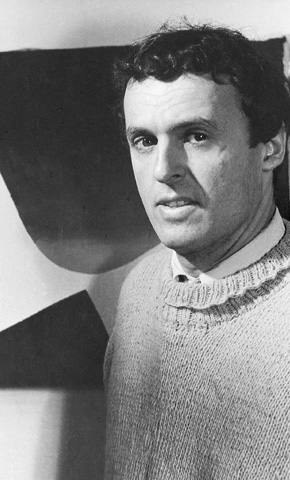|
"What does this new art want? It largely turns away from the representational and achieves this through new color and form ... It is an exciting adventure to distance oneself from reality and to enchant things ... Here, the possibilities are unlimited ... First of all, there is the color. Weightily, it comes first." After the end of the war, the few financial resources available are initially used to clear rubble, repair bombed-out houses and build temporary housing. A boom in housing construction finally emerges with the currency reform. It was not until 1949 that Rupprecht Geiger again received commissions as an architect and worked together with his wife on various private houses and housing estates in and around Munich until 1962. Since Rupprecht Geiger cannot work in his learned profession in the first post-war years, he concentrates on painting. Thanks to a professorship at the Munich Academy from 1946, Willi Geiger is provided with a studio at Heßstraße 27. He not only enables his son to paint there once a week in complete seclusion, but also provides him with painting utensils and paints. From the summer of 1948, Rupprecht Geiger also makes use of the precious ingredients from the care packages sent by Hilla von Rebay. Due to the scarcity of materials, many of the works created during this period are painted on both sides and done in mixed media; however, Rupprecht Geiger soon works primarily in egg tempera, a technique he will use until the mid-1950s. During these years, he practices various styles on the fly. He reflects on various stylistic possibilities that are considered at the time as a contemporary expression: "I have different styles - Expressionism, Surrealism, Naturalism - in phases of a few weeks on myself worked off, dealt with systematically." (Exh.cat. St. Petersburg 1994, p. 154). |
|
In few created landscapes or still lifes he deals with Reminiscences of Greece or processes impressions from the post-war period. He concentrates on a strong, expressive colorfulness and gradually moves away from a representational design. In this artistic search for orientation, he also experimented with the picture format: in the winter of 1948-49 he created a small Work group of irregular formats, which only its rediscovery at the end of the seventies will allow Rupprecht Geiger to be considered a pioneer in this field, long before the 'shaped canvases' of the Americans. The variety of forms is pushed back in favor of a clear color scheme. The irregular format was intended to bypass the association of a landscape vista and increase abstraction. The departure from the traditional rectangle is too daring for him to publicize his latest achievement at the time. With this group of works, Rupprecht Geiger leaves behind the tradition of picture titles that seem all too associative to him and begins to number his paintings consecutively. In addition, he signs them only on the back, since he finds the signature a disturbing element on the painting surface. As early as 1945, Rupprecht Geiger took part in one of the very first exhibitions after the Second World War, in the town hall of Prien am Chiemsee. From 1946 on, he participated in group exhibitions, including the third show of modern art with the provocative title Extreme Malerei (Extreme Painting) in the Schaezlerpalais in Augsburg in February 1947. It was the first attempt since the end of the war to present the most important styles of the post-war period by means of striking representatives. There, Rupprecht Geiger is not only exhibited alongside well-known painters such as Willi Baumeister or Fritz Winter, but also gets to know some exhibiting artist colleagues as well as John Anthony Thwaites, the British consul in Munich at the time. From the ensuing discussions in the avant-garde gallery Otto Stangl sprang the idea of founding a group of modern painters, the later Group ZEN 49. The common goal is to pave the way again for abstract art in post-war Germany. Rupprecht Geiger was also invited to exhibit abroad. In the summer of 1948 three surreal landscapes shown at the IIIème Salon des Réalités Nouvelles in Paris. For this occasion he travels to the French capital, is a guest of Jean Dubuffet for two weeks and gets to know the world of 'art brut'. In an exhibition review of the first international exhibition of contemporary art in Germany - an attempt to document the current all-German intellectual situation - the works of Rupprecht Geiger are counted by Wolfgang Petzet among the representative examples of non-objective painting. Author: Julia Geiger |

